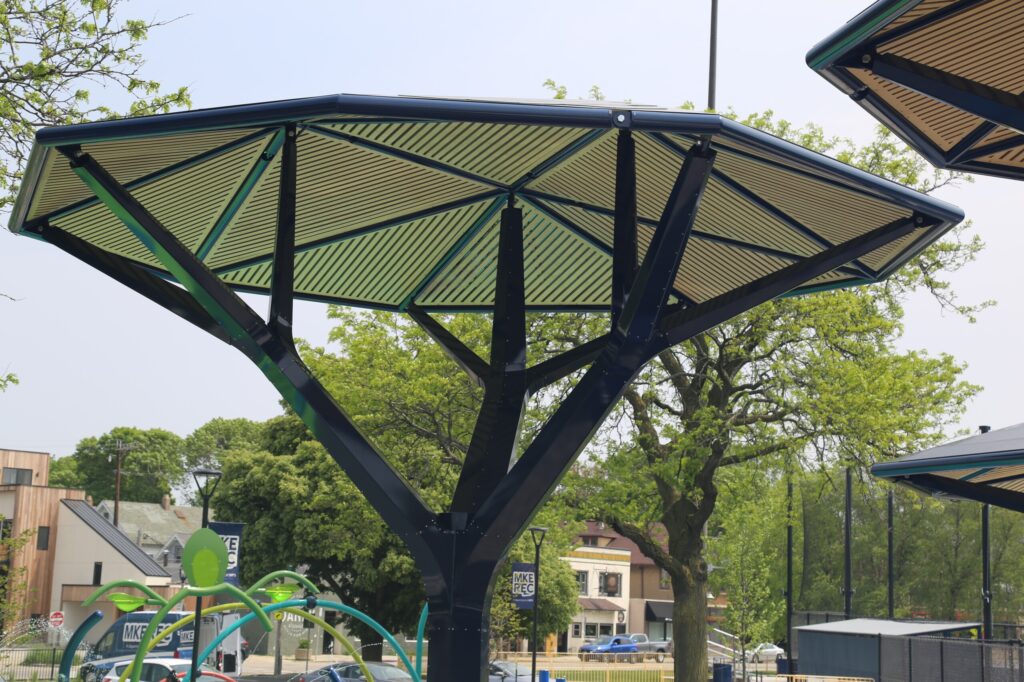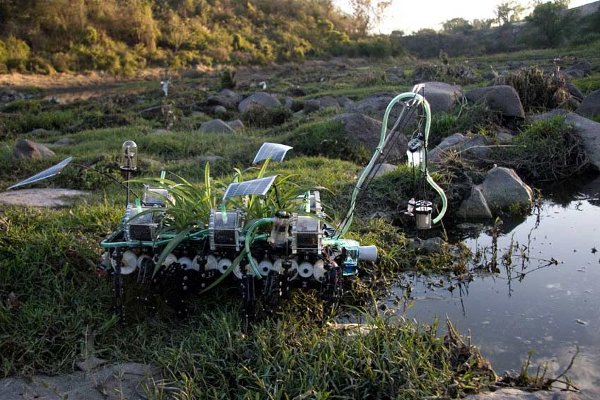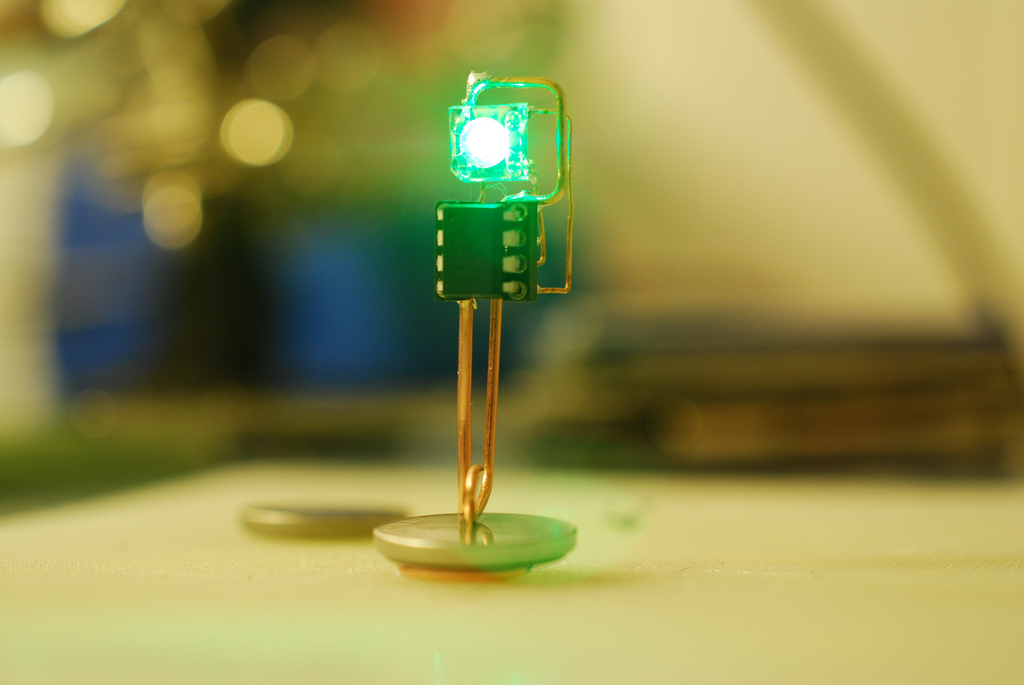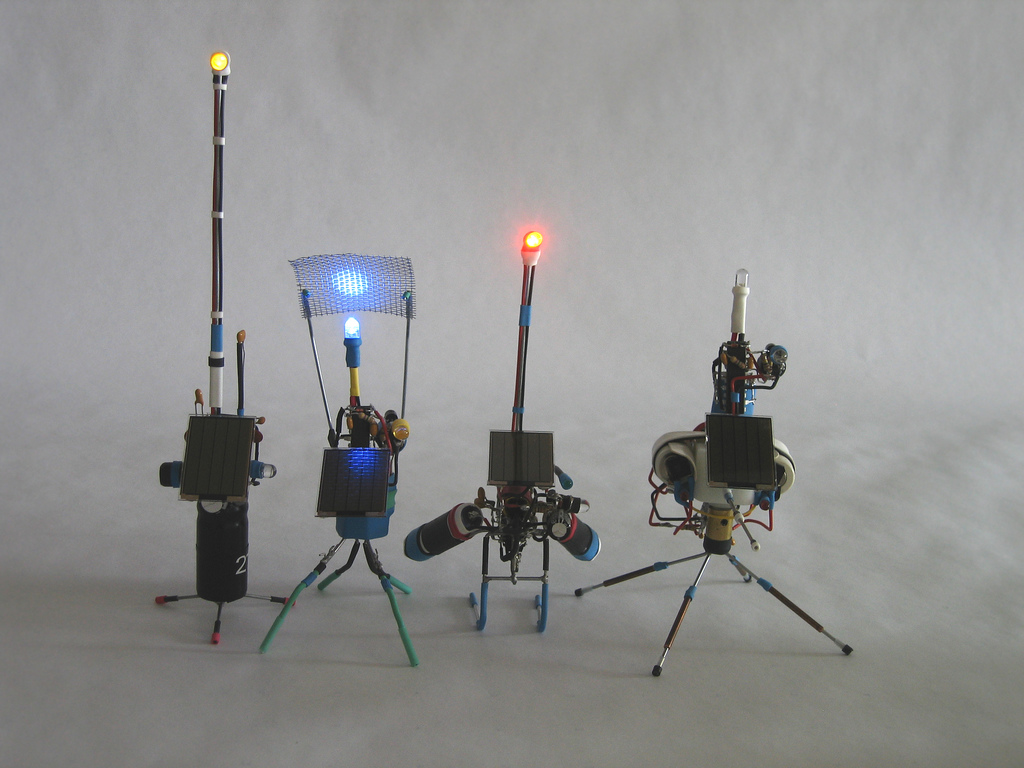
Eau Claire, Wisconsin’s SolarForma has created these solar panel supporting tree structures they call E-Cacia. Each tree produces 3.5 kW of electricity, while simultaneously providing 440 square feet of usable shade.

Eau Claire, Wisconsin’s SolarForma has created these solar panel supporting tree structures they call E-Cacia. Each tree produces 3.5 kW of electricity, while simultaneously providing 440 square feet of usable shade.

The solar power and auto-on features of the Kimono Lantern reminded me pummpers and and SolarRobotic’s PumLantern, but much less spastic. (See video after the jump.)
The PumLantern’s case is clearly inspired by Japanese tatami lamps, but with stencils to break up the light. I recently saw another lamp that did something similar. I can’t say I approve of the choice of stencils, but I do like the idea of shapes covering the individual panels of the lamp.


The folks at TokyoHackerSpace, have taken a break from building geiger counters, and built this rather cute table lamp. According to the write up, this solar powered automatic light was originally intended for tables at a local restaurant.
TokyoHakerSpace’s Kimono Lamp looks a lot like a DIY version of the €35 Marmaled / Jelly Lamp from Semiki, but more technically advanced. (The Marmaled uses a tilt switch and two AAA batteries.) Really, when it comes down to it, the Marmaled’s jar and black label is what sets it apart. Of course, you can always buy jars wholesale
Video of the Kimono Lamp in action after the jump.

d&@le Concepts concepts (nomme de art for Alessandro De Ambrogio and Carlos Basanta) have created the GUL Two, a solar powered LED plant that lights up at night. Currently installed at in the Elemental Gardens at Pacific National Exhibition in Vancouver.

Ah, Vivien Muller! Is there anything you make that I won’t post? Above is Electree, his latest creation. It’s a purple Photonsynthese, and is being presented at the Palais de Tokyo in Paris on the occasion of the 1.618 sustainable luxury fair.
Limited to 1000 editions. Price €4950 (~ $6354).
I like it. I like the blue of Photonsynthese more though. Don’t like the price at all. More disturbingly, it’s just too derivative of his earlier work. It seems like the big change in this one is that it uses rare earth magnets instead of headphone jacks to mount the solar cells. Really, really don’t like that price.

Now this is nifty.
We Make Money, Not Art interviews, Gilberto Esparza about his Plantas Nómadas (Nomadic Plants), an autonomous walking robot that is powered by a combination of solar cells and a microbial fuel cell. When the fuel cell output drops beneath some threshold, the bot seeks out a water source, extends a proboscis and refills the fuel cell. Additional water is used nourish a colony of on board plants.
Gilberto’s earlier work is equally interesting. Parasitos Urbanos (Urban Parasites) (flashless site) was a series of robots inductively powered from electrical transmission lines that would move through the urban environment mimicking sounds they encounter.

Jim Blackhurst’s SmartLED SolarTherm is a minimalist information display. Consisting of an RGB LED, a watch, and an ATTiny25 microcontroller. The chip contains a temperature sensor whose reading is displayed as light pulses. According the comments on Makezine, the internal temperature sensor is +/- 10 C (+/- 18 F), so its not very useful.

SolarTherm is simpar to M27’s Zach DeBord’s pummers. These charge a capacitor from a solar cell, and when the light level drops, the capacitor discharges, and causes an LED to blink.
While as an ambient displays these are visually interesting, especially Zach DeBord’s pummers, these seem to suffer from the main problem with all ambient displays. They trade simplicity for usefulness.
I want the display to be both pretty, but also informative. The display needs to be immediately interrogated. Similar to the how a grandfather clock provides a chime ever 15 minutes to an hour, but also can be viewed in order to learn the exact time. I’m thinking of something like Riedi and Gloor’s Weather Diorama.
Things like Nabaztag or the infinitely more endearing, Michael Kaminsky and Paul Dourish‘s SWEETPEA (aka “The Microsoft Barney Paper”) are more confusing than anything. Even baseball signs aren’t that confusing.
Maybe the best ambient display I’ve seen was simply a string hanging from a DC small motor wired directly into an ethernet cable. As packets would pass, the motor would be powered, causing the string to wiggle. As the network activity increased, so would the vigorousness of the string’s dancing. The great thing about this display is that it’s immediately and intuitively interpretable, while something more complex requires the user to learn some of sign language.
I’ve been thinking more about solar plants recently. I like how these projects combine both form and function. I’ve been thinking about what I’d like in one of these, and how one would be made. First, the power being collected by the solar cells needs to go somewhere. It could just feed back into the device, which is exactly what happens with plants, but part of me likes the idea of having the sculpture(?) have a practical use as well. If I want practicality, then USB ports for charging an iPod or a phone that I don’t have would be nice. At least one port, but four would be more than plenty. I’m leaning towards the solar cells charging some li-ion or nicad battery coupled with something like a Minty Boost.
The second feature I’ve been hammering the previous electronic plants I’ve looked at is the movement, specifically heliotropism (i.e. sun tracking). It’s an interesting feature, and it would increase the power to the photovoltaics. I don’t like the idea of the hearing servos move, so that means nitinol wires, which also have the quality of more closely resembling natural motion by simply expanding and contracting. The next question then becomes, what form would the motion would take?
If rigid photovoltaics are used, then panel could be mounted to a universal joint with the two outside corners independently controlled by nitinol. The other idea is to use flexible photovoltaics and hopefully no hinges and joints.
Another interesting idea is to think about deployable structures, which would seem to imply the use of flexible photovoltaics. It’s not exactly the heliotropism I was thinking of, but it would be cool if the “leaves” opened up in the day, tracked the light, and then closed at night.
Doing all of this nitinol might be kind of difficult. Heating nitinol causes it to contract in the 3 – 5 % range, doesn’t seem like much. This also means that for a deployable structure, it needs to collapse when the wires are extended,
Will I actually build this? Probably not, but it is something I’ve been thinking about. Perhaps it would give me an excuse to visit Noisebridge.

Vivien Muller (previously) has created a new “plant,” Orkys. This one uses flexible photovoltaics as leaves to light what appears to be LEDs in in the flowers.
I prefer his previous work, PhotonSynthese more though. Aesthetically, it’s more pleasing with the brushed metal stems and the blue leaves, instead of the all black stem and leaves. However, the more flexible materials in Orkys makes it easier to introduce nitnol wires in the leaves for sun tracking. Also, PhotonSynthese does something, while Orkys just sits there and looks pretty. There’s no reason why you can’t have something like this do both.

For Core77‘s 2009 Greener Gadgets competition, Vincent Gerkens of Belgium applied photovoltaics (similar to the ones seen before) to one side of venetian blinds and a electroluminescent foil to the other side to create Blight. During the day, it blocks light, but at night it releases it (so to speak).